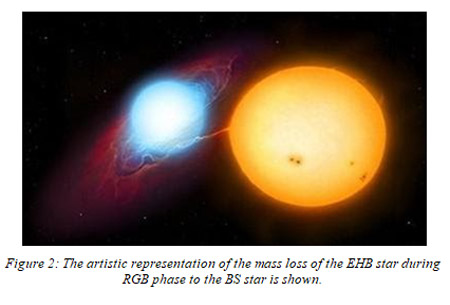 A pair of unusual stars spotted in a globular cluster-- a spherical collection of stars that orbits a galactic core, have given scientists clues about the evolution of such unusual stars.
A pair of unusual stars spotted in a globular cluster-- a spherical collection of stars that orbits a galactic core, have given scientists clues about the evolution of such unusual stars.
While in usual stars like the Sun, the hydrogen at the core converts to Helium through nuclear fusion resulting in a core of helium and later move towards the giant phase, in unusual stars like Blue stragglers (BS), this route is not followed. Thus their evolution cannot be explained by the evolutionary theories of usual Sun-like stars.
Scientists from the Indian Institute of Astrophysics (IIA), Bengaluru, and Aryabhatta Research Institute of Observational Sciences (ARIES), both autonomous institutes under the Department of Science and Technology (DST), Govt. of India, in a collaborative study have spotted an unusual binary pair in the outskirts of the Globular cluster NGC1851. The unusual pair consisting of the blue straggler (BS) companion to extreme horizontal branch (EHB) star has been detected for the first time. They form a binary system is located in the outskirts of the cluster, where the crowding of stars is much less, and binaries can survive from stellar collisions. The pair is unusual since various scientists have tried to find binaries in the EHB region, but they found that spotting binaries in the EHB region is rare. The study was carried out using the Ultra-Violet Imaging Telescope (UVIT) on board AstroSat, India's first dedicated multi-wavelength space observatory.
 The details of these two types of stars have been debated since their discovery. The study led by Gaurav Singh and Ramakant S. Yadav from ARIES and Snehalata Sahu and Annapurni Subramaniam from IIA, Bengaluru, which has been recently accepted for publication in journal The Astrophysical Journal, unravels the mechanism of their evolution and how they thrive in symbiosis. The study implies that the BS star might have got its extra mass from the EHB star when it was in the red giant branch (RGB) phase of evolution. This unusual pair is not only important for discovery of binaries in EHB, but it also explains the formation mechanism of both BSS and EHB, which are still debatable. The discovery of this binary system can serve as an important target for future spectroscopic study to understand the formation of unusual stars.
The details of these two types of stars have been debated since their discovery. The study led by Gaurav Singh and Ramakant S. Yadav from ARIES and Snehalata Sahu and Annapurni Subramaniam from IIA, Bengaluru, which has been recently accepted for publication in journal The Astrophysical Journal, unravels the mechanism of their evolution and how they thrive in symbiosis. The study implies that the BS star might have got its extra mass from the EHB star when it was in the red giant branch (RGB) phase of evolution. This unusual pair is not only important for discovery of binaries in EHB, but it also explains the formation mechanism of both BSS and EHB, which are still debatable. The discovery of this binary system can serve as an important target for future spectroscopic study to understand the formation of unusual stars.
For more details, Gaurav Singh (gaurav[at]aries[dot]res[dot]in) can be contacted.






























